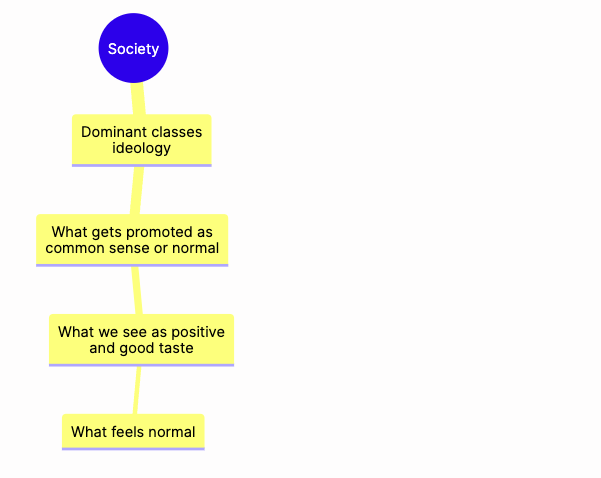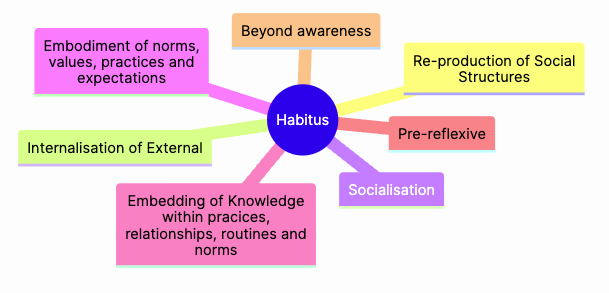Following on from my little presentation on Bourdieu - this is a more focused summary of the best bits of his theory.
Social Structures
Social structures are enduring and regular patterns of social arrangements and overarching systems that organise and give form to social life. Social structures come into being from the relationships and interactions between individuals and groups.
Social structures are shaped by the dispositions of individuals and the dynamics of power defined by the accumulation of various forms of capital within Social fields.
Insights: Society is a defined by power dynamics that arises from the accumulation of capital. The successful individuals form dominant classes and their views become the dominant views of the society. The re-production of the social structures takes place through Habitus.
Habitus
Social structures tend to re-produce and favour status quo. The mechanism for re-production of social structures is Habitus.
Habitus is the internalisation or embodiment of the social reality around us. Since our social reality is the social structures that we’re born into and grow up in - that is what we embody and this disposition is also called Habitus.
The embodiment happens through socialisation - growing up in a family, going through education, experiencing culture, friends, institutions …
In the course of acquiring Habitus we internalise the norms, values, practices, and expectations of the social environment.
The end product is an individual disposition which is ingrained ways of thinking, feeling, perceiving and acting.
Habitus represents the context of the world. It’s a pre-reflective, embodied nature of human existence - reflected in social structures and experiences. Humans don’t exist outside of it - the habitus is defined temporally, historically, situationally and relationally. One is always to be found within a habitus. We belong in the habitus without a conscious awareness - it is fundamental aspect of our reality. There’s a tension between the structure (or norms, value mechanisms) and agency - one can be authentic despite the conditioning of the structures of the world.
We find ourselves being thrown into the habitus and that’s another Heideggerian reference!
Insights: Through Habitus we:
1) internalise what's external - meaning we translate the substance of the social structures and turn it into a biological emulation of it
2) embody pre-reflexive knowledge - meaning we adopt all that knowledge and make it part of our axiomatic knowledge rather than something open to contemplation and evaluation
3) embed that knowledge in practice - meaning that we further externalise that same knowledge through everything we do
Pre-reflexive Knowledge
We embody social structures in the form of “pre-reflexive” knowledge and that means that we’re not aware of it as being separate of us or externally injected - it feels like it’s foundational.
It’s a type of understanding or awareness that occurs prior to reflective thought or conscious analysis. It is knowledge that is not the result of deliberate introspection or reasoning but is instead immediate and often non-conceptual.
Pre-reflexive knowledge is embodied, embedded and unconscious. It is embodied in the body, embedded within practices, relationships, routines and norms and often taken for granted.
It’s fundamental to all other forms of knowledge because it is part of how we process reality, reflect and think about experiences.
Insights: Some of the knowledge that we acquire through socialisation and consider logically inferred and common sense is actually not.
Life Meaning and Being
A meaningful life requires engaging with the reality. For Bourdieu life meaning is a social structure that emerges from our interactions with the world.
This is where I’d pause a bit and add that many thinkers allow for life meaning to emanate from within. Unfortunately, the inclusion of the value generated internally doesn’t work within the Bourdieu’s framework of various types of capital that are produced in the process of valorisation of Being.
Rather than treating it as a stumbling block, I’d personally rather jump over it and go with this narrow definition of life meaning that gets valorised by the society.
Individual act of our engagement is called Being and in the course of living life - we accumulate Being.
Being has intensity and gravity. The more intense our Being is, the more valuable it is. The more we do it - the more it pulls us in. Being carries risks and rewards.
Being and Social Fields
Individuals engage with the world (society) through Social fields. They take stakes with their Being and compete for positions by accumulating various forms of capital.
Types of Capital
Capital is how individual’s Being gets valorised by the society. There are different types of capital that one can earn.
-
Financial capital is the physical wealth.
-
Cultural capital (across different social fields - individual’s cultural capital varies)
- Embedded cultural capital is the value and the potential of our disposition. Everything we have acquired during internalisation through socialisation - our behaviours, skills, the actual knowledge of particular social field or broadly navigating the world, etc…
- Institutionalised cultural capital is our qualifications and credentials.
- Objectified cultural capital - various objects that are seen as indicators of sophistication, taste, engagement, education…
-
Social capital is an obligation and expectation, arising from a trust in a relationship, that a favour rendered would be reciprocated. It can also be described as a “high level of social trust and reciprocity of civic engagement” or an investable value of actual and potential resources that an individual or a group has access to through their network of social relationships.
-
Symbolic capital is the prestige, honour and recognition you accrue within a social field.
Society and Worldviews
Our habitus provides a set of cognitive and evaluative structures through which the world is understood. Habitus defines what individuals consider to be possible, impossible, probable, improbable, right, wrong …
So, for Bourdieu - this wholeness of a worldview gets injected into a person through habitus using the value that social structures produce in recognition of certain type of engagement. Whatever is valued socially is somehow transmutated into a value that gets rewarded for adhering to those valued things, material or immaterial…
Within social fields we act in accordance with our habitus because it feels right or normal, given the worldview we have.
All our views are perspectives of the world and the struggle between these perspectives is the struggle for the making and the unmaking of the world!
Social fields are arenas of struggle where individuals and groups compete for the distribution of capital and the power it confers. Social classes emerge from social positions that individuals hold in the field, based on their capital.
The dominant classes use their power and influence to legitimise their views as dominant views through social institutions.
Insight: All views are linked to ideologies and are part of the struggle to disrupt, save or replace dominant worldviews
Misrecognition in society
There’s a mystification or mis-recognition in the society and that is directly linked to the inability of non dominant classes to see and understand the condition of their own subjugation - of being dominated. Misrecognition is a way of domination.
People enter into education, for example, to give them a better chance of getting access to the labour market because they want a job - but the education is a system based on the principles of class relations and through education people reproduce those structures.
The school appears autonomous but at the same time is valorising the cultural capital of the dominant social structures (he refers to classes). There’s a certain mis-recognition of what’s going on.
Dominant class stands behind a certain cultural taste and presents itself as more refined.
Middle classes taste is driven by emulation of the dominant class and this is where the blurring of class boundaries takes place to further mask the origins.
Working classes are left to play a catch-up game while pre-occupied with meeting economic necessity.
The real distinction of the dominant class comes from privileged access to wealth and education, but appears to be innate - and with such advantage in terms of habitus and such wealth of various types of capital - these people dominate all spheres of life.
This class structure is mirrored in the distribution of cultural practices and patterns of consumption.
The question of consciousness is equally mystified through the same mechanism of dominating. Relative positions in the framework of psychological and conscioussnes development can be easily obscured by the inability of the lower levels recognising that a higher level is not a lower level.
The state has the monopoly of the legitimate symbolic power. It’s in a negotiated relationship with field to determine which categories and classifications should be current in the society and they simulate, perpetuate and promote bad sense in classes.
Symbolic violence
Or Symbolic domination is the intention and ability of the dominant classes to present the existing social hierarchy, dominant worldviews and associated norms, values and practices as justified on the basis of inherent properties of people or knowledge.
Power is maintained and legitimised in society through the imposition of schemes of perception and thought that appear neutral and natural but actually reflect and re-enforce power relations within a field.
This process is often mis-recognised by those subjected to it leading to a tacit acceptance of social hierarchies.
Doxa - the set of beliefs and values taken for granted within the field defining the realm between what’s thinkable and sayable.
Doxa shapes the perception of what is natural or common sensical and contributes to the reproduction of social order by confining the range of possible actions and thoughts.
From Location to Trajectory
-
Location in Social Space:
Bourdieu conceptualises social space as a multidimensional structure where positions are determined by the volume and composition of capital (economic, cultural, social, and symbolic) that agents possess. The location of an individual or group within this space is indicative of their social class.
-
Trajectories Through Social Space:
- Trajectories refer to the paths that individuals and groups take through social space over time. These paths can be upward or downward, stable or erratic, and are shaped by the accumulation or depletion of capital, life events, choices, and opportunities.
- Social mobility, or the lack thereof, is a key aspect of trajectories. Bourdieu’s analysis recognises that while habitus tends to reproduce existing social conditions, it is also adaptable and can change in response to new experiences and conditions.
- Trajectories are not just about economic success or failure; they also involve changes in cultural practices, social networks, and the symbolic aspects of social life.
-
From Location to Trajectory:
- Bourdieu’s approach moves beyond a static understanding of social class as a fixed location. Instead, he emphasises the dynamic aspect of social life, where past and present conditions, along with the agency of individuals, contribute to ongoing social processes.
- The concept of trajectory allows for an analysis of how individuals and groups navigate the social world, how they use their various forms of capital to maintain or improve their position, and how they adapt their habitus in response to changing circumstances.
- This perspective highlights the fluidity of social life and the potential for change, while also acknowledging the powerful forces of social reproduction that can limit social mobility and perpetuate inequality.
While studying Bourdieu - I realised that his concept of humans as relational beings is very similar to Heidegger’s “Being-with-Others”. While Heidegger has a whole range of related relational sub-concepts - Being-in-the-World, Being-with-Oneself, Dasein (self-awareness)… Bourdieu doesn’t seem to follow the same ontological inquiries.
However, the internalisation of the external and the consequent building of one’s disposition can be seen as something approaching Heidegger’s Dasein. Similarly, cultural capital that appears in the context of acquiring disposition might be seen as a way of acknowledging that some Being can be valorised internally, but ultimately finds its real value through the external appreciation. For example, one’s appreciation of a sunset might (indirectly) result in the augmentation of the cultural capital.


